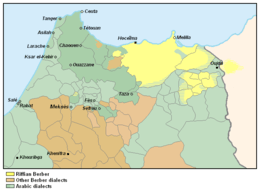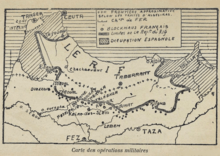Rifian people
| Total population | |
|---|---|
| 1.4 million (4% of Moroccan population) (2017) [1] | |
| Languages | |
| Rifian | |
| Religion | |
| Sunni Islam (predominant),[2][3] Roman Catholicism (especially in Melilla, Spain)[4] |

The Rifian people, in Tarifit: Irifiyen, by others also known as Riff, Riyefa or Ruafa, are a Berber speaking people of Northwestern Africa, who derive their name from the Rif region in the northern edge of Morocco.[3] Being a part to Gibraltar Arc and living close to the Iberian peninsula, communities of Rifian people are found both in northeastern Morocco and southern Spain, as well as elsewhere in Western Europe and North Africa. Their native settlements were Arabized and Islamized in and after the 7th-century, during the early expansion of Islam.[5] They are overwhelmingly maraboutic Sunni Muslims, but retain their pre-Islamic traditions such as high status for Rifian women.[3]
According to Irina Casado i Aijon, Rifian people have traditionally organized themselves under "patrilineality and patrilocality principles".[5] The oldest man in the household commands authority and responsibility for decisions, while women jointly care for the young and sick without any discrimination. The Rifian people have retained some of their traditional occupations, such as working in pig meat industry, despite being Muslims and "pig meat" being haram in Islam.[5] Like other Berbers, temporary migration is an accepted tradition.[6] The Rifians have been a significant source of Morocco emigrants into some European countries such as the Netherlands.[7][8][9]
The Rifian people speak the Tamazight group of Berber languages, specifically Tarifit or Zenatiya.[3] The languages spoken depend on the region, with many Rifian who speak a Berber language also speaking Arabic or Spanish. Nineteen groups or social units of Rifians are known: 5 in the west along the Mediterranean coast which speak Arabic, 7 in the centre of which one speaks mainly Arabic and rest Rif language, 5 in the east and 2 in the southeastern desert area also speak the Rif-Berber language.[2]
They have inhabited an impoverished and an eroded, deforested, poorly irrigated region. Poverty rate and infant mortality rates among the Rifian people has been high, according to a study published in 1980 by Terri Joseph.[10] The Rifians have lived a largely settled, agricultural lifestyle, using hand tools, oxen and cattle to plow the steeply terraced land in their valleys. Horticultural produce along with sheep and goat meat, cheese, and milk provide the traditional sustenance.[10] Some practice sardine-seining along the Mediterranean coast.[2]

The Rifian people have experienced numerous wars over their history. Some of their cultural traditions reflects and remembers this history, such as the singing and dancing of Ayara Liyara, Ayara Labuya, which literally means "Oh Lady oh Lady, oh Lady Buya" and is accompanied by izran (couplets) and addjun (tambourine tapping).[11] This tradition, states Hsain Ilahiane, is linked to the 11th-century destruction and deaths of the Rifian fathers during the raid by the Almoravid leader Yusuf ibn Tashfin.[11] In more modern times, the Rif War caused numerous deaths of Rifian people and of Spanish as well as French soldiers. The Rif War witnessed the use of chemical weapons in the 1920s by the Spanish army.[12][13]
In 1958, some Rifian communities launched a modern nationalist movement.[3] In the decades that followed, the Rif region has witnessed Rifian demonstrations and demands for recognition of Rifian language, culture and Berber studies at schools and universities.[9] A resurgent Rifian nationalism in 2010, their protests in 2013 and protests in 2017 for hogra – a humiliating treatment by an abusive state, has drawn public attention, as well as claims of brutal suppression by Moroccan authorities.[3][14][15]
Tribes and tribal groups
The Rifians are divided into these tribes and tribal groups:[16]
- Ibuqquyen, a tribal group.
- Ayt Uryaɣel, a tribal group.
- Ayt Ɛammart, a tribal group.
- Igzinnayen, a tribal group.
- Ayt Tuzin, a tribal group.
- Timsaman, a tribal group.
- Ayt Sɛid, a tribe.
- Ayt Wuricik, a tribe.
- Tafarsit, a tribe.
- Ibdarsen (or Mtalsa), a tribe.
- Ayt Bu Yihyi
- Iqarɛayen, five tribal confederacies.
- Ikebdanen (or Kebdana)
- Ayt Yittuft
- Ayt Bu Frah, partly arabic-speaking.
See also
References
- ↑ Haut commissariat au Plan, Moroccan Kingdom, Haut commissariat au Plan. "Recensement général de la Maroc". HCP (in Franch). Haut commissariat du Plan. Retrieved 16 August 2016.
- 1 2 3 The Editors of Encyclopædia Britannica, Rif people, Encyclopaedia Britannica
- 1 2 3 4 5 6 James B. Minahan (2016). Encyclopedia of Stateless Nations: Ethnic and National Groups around the World, 2nd Edition. ABC-CLIO. pp. 352–352. ISBN 978-1-61069-954-9.
- ↑ Lucien Oulahbib, Le monde arabe existe-t-il ?, page 12, 2005, Editions de Paris, Paris.
- 1 2 3 Irina Casado i Aijon (2013). Laura Oso; Natalia Ribas-Mateos, eds. The International Handbook on Gender, Migration and Transnationalism. Edward Elgar Publishing. pp. 450 with notes 2-8. ISBN 978-1-78195-147-7.
- ↑ Irina Casado i Aijon (2013). Laura Oso; Natalia Ribas-Mateos, eds. The International Handbook on Gender, Migration and Transnationalism. Edward Elgar Publishing. pp. 439–449. ISBN 978-1-78195-147-7.
- ↑ Malcolm Klein; Hans-Jürgen Kerner; Cheryl Maxson; et al. (2012). The Eurogang Paradox: Street Gangs and Youth Groups in the U.S. and Europe. Springer Science. pp. 166–167. ISBN 978-94-010-0882-2.
- ↑ Maurice Crul; Flip Lindo; Ching Lin Pang (1999). Culture, Structure and Beyond. Het Spinhuis. pp. 66–67. ISBN 978-90-5589-173-3.
- 1 2 James Minahan (2002). Encyclopedia of the Stateless Nations: L-R. Greenwood Publishing. pp. 1590–1592. ISBN 978-0-313-32111-5.
- 1 2 Joseph, Terri Brint (1980). "Poetry as a Strategy of Power: The Case of Rifian Berber Women". Signs: Journal of Women in Culture and Society. University of Chicago Press. 5 (3): 418–434. doi:10.1086/493728.
- 1 2 Hsain Ilahiane (2017). Historical Dictionary of the Berbers (Imazighen). Rowman & Littlefield. p. 44. ISBN 978-1-4422-8182-0.
- ↑ James A. Romano Jr.; Harry Salem; Brian J. Lukey (2007). Chemical Warfare Agents: Chemistry, Pharmacology, Toxicology, and Therapeutics, Second Edition. CRC Press. p. 11. ISBN 978-1-4200-4662-5.
- ↑ Martin Thomas (2008). Empires of Intelligence: Security Services and Colonial Disorder After 1914. University of California Press. pp. 147–149. ISBN 978-0-520-25117-5.
- ↑ David S. Woolman (1968). Rebels in the Rif: Abd el Krim and the Rif Rebellion. Stanford University Press. pp. 1–17. ISBN 978-08047-066-43.
- ↑ Rough in the Rif: Morocco’s unrest is worsening, The Economist (July 8 2017), Quote: "The trouble began in October after a fishmonger called Mouhcine Fikri was crushed by a garbage compactor at a port in Al Hoceima, which is located in the Rif, a northern mountain region with a rebellious streak. Fikri was trying to retrieve fish that had been confiscated by the authorities. To locals, his death was a striking example of hogra—humiliating treatment by an abusive state. (...) The government has since exacerbated the situation with yet more hogra. In May it called the protesters separatists, though most are not, and suggested that they were foreign agents. (...) The unrest not only increased, but spread to other parts of the country, including Rabat, the capital, where on June 11th thousands of people rallied in support of the Rifians. All told, it is the largest display of public anger in Morocco since the Arab spring in 2011."
- ↑ Hart, David M. (2014). Tribe and Society in Rural Morocco. Routledge. p. 105. ISBN 9781135302542.